10 Bathroom Floor Tile Ideas for Small Spaces
When you’re designing a small bathroom, the choice of floor tile can make all the difference in maximizing both space and style. You might want to contemplate how different layouts and colors can create the illusion of more room or add a unique character to the space. From diagonal layouts to light-colored options, every tile choice impacts the overall feel. As you investigate these ideas, specifically think about how textures and patterns not only improve aesthetics but also functionality. Let’s examine some innovative tile concepts that could redefine your compact bathroom experience.
Diagonal Tile Layouts
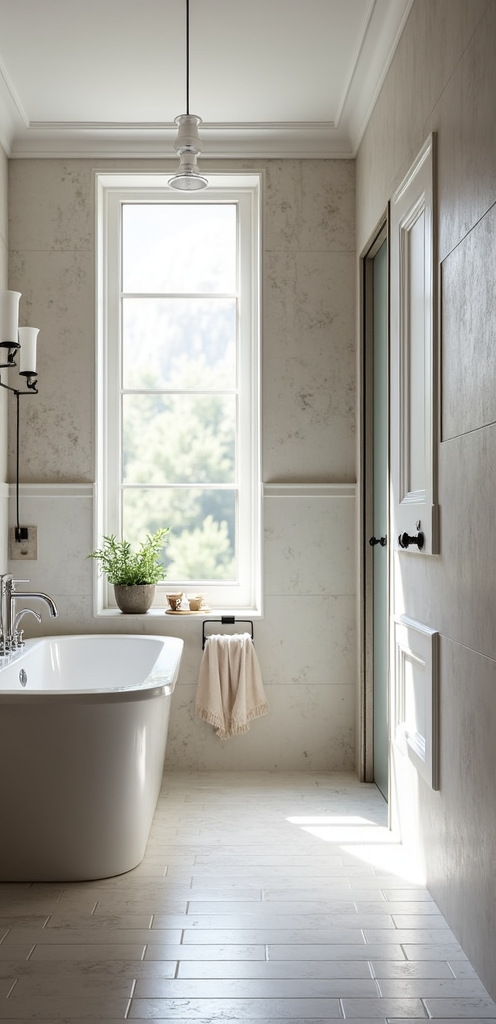
Regarding transforming your bathroom, diagonal tile layouts can create a dynamic visual impact that draws the eye and improves the space. This layout involves installing tiles at a 45-degree angle instead of straight, adding depth and interest.
First, choose your tile size; smaller tiles often work better in tight areas, as they can create a more intricate pattern. Next, measure your space carefully to determine how much tile you’ll need.
Lay out your tiles on the floor without adhesive to visualize how they’ll look. Mark your starting point, typically at the center of the room, and work outward.
Finally, use spacers to guarantee even gaps between tiles, and let the adhesive set properly before grouting.
Large Format Tiles
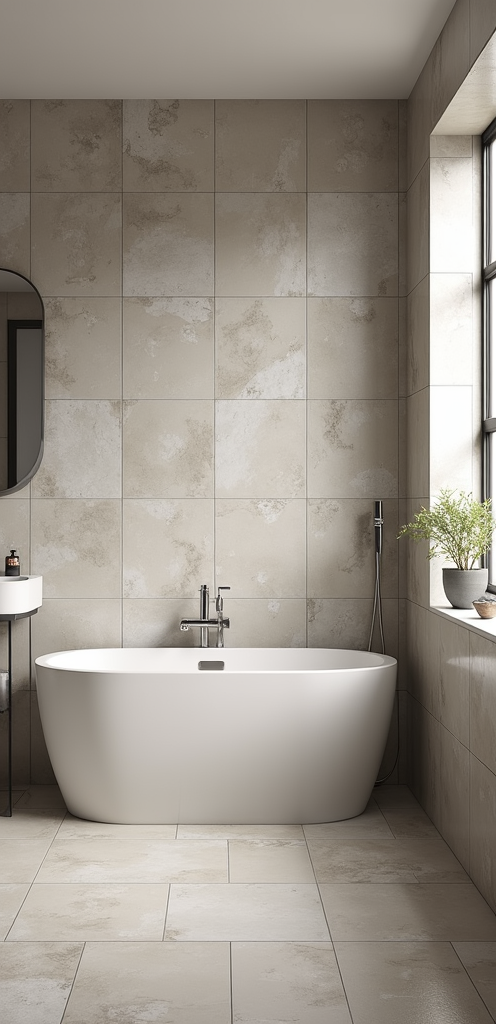
For a sleek and modern look, large format tiles offer an impressive solution in bathroom design. These tiles, typically 12×24 inches or larger, reduce grout lines, creating a more seamless appearance. When you use them, the space feels bigger and more open.
Installation is straightforward but requires careful planning. Start by measuring your floor and selecting a layout that minimizes cuts. If you’re working with a small area, laying the tiles in a straight pattern can be easier to manage.
Remember to choose a slip-resistant finish for safety, especially in wet areas.
While large format tiles can be heavier, they’re durable and can withstand moisture, making them a smart choice for small bathroom spaces.
Light-Colored Options
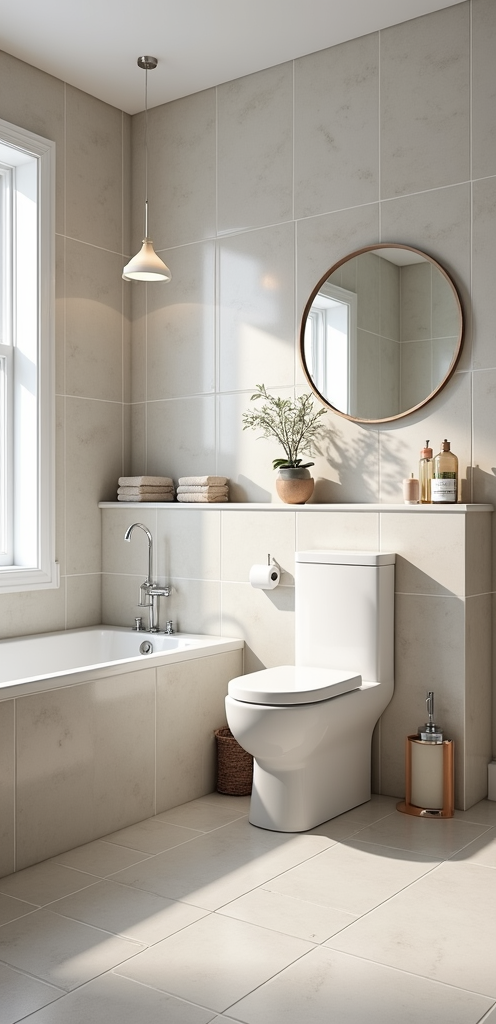
Choosing light-colored tiles can transform a bathroom into a serene retreat, enhancing the sense of space and brightness. Light colors like white, beige, and soft pastels reflect more light, making your small bathroom feel larger.
Consider using large-format tiles; fewer grout lines create a streamlined look. Glossy finishes add to the brightness, reflecting light and creating an illusion of space.
When selecting tiles, think about the texture. Matte tiles offer a subtle contrast but still keep the space airy. You can also mix different light shades for a layered effect without overwhelming the room.
Finally, don’t forget about the grout—light grout can unify the look, while slightly darker grout can add definition and depth to your design.
Herringbone Patterns
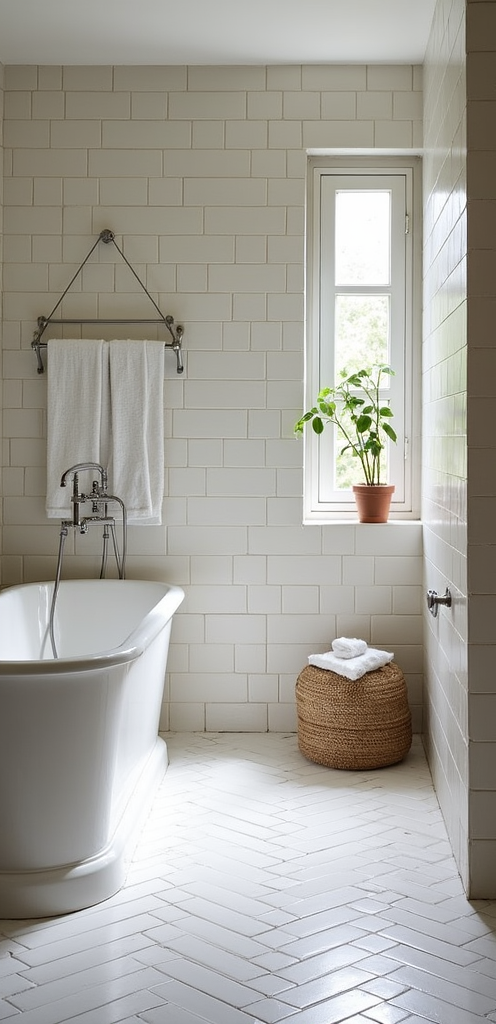
Light-colored tiles set a calm backdrop, but if you’re looking to add a unique touch, herringbone patterns can improve your bathroom’s design. This zigzag pattern creates visual interest, making your small space feel larger.
To achieve this look, choose rectangular tiles and lay them at 45-degree angles. Opt for a color that complements your overall theme; neutral tones work well for a softer look, while bolder shades can create a striking contrast.
Start with a clean, leveled surface, and verify you have the right adhesive. As you install each tile, use spacers for even grout lines. Finally, choose a grout color that either matches or contrasts with your tiles for added impact.
Your herringbone floor will become a stunning focal point!
Glossy Finishes
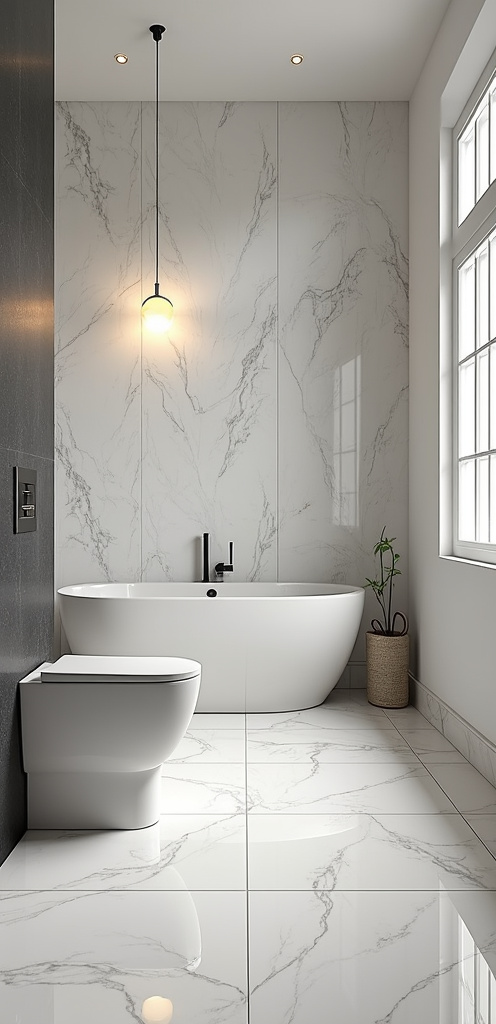
A sleek aesthetic transforms your bathroom into a modern oasis, and glossy finishes are an excellent way to achieve that shine. These tiles reflect light, making your space feel brighter and larger. You can choose from ceramic, porcelain, or glass tiles, each offering different benefits.
Ceramic tiles are durable and affordable, while porcelain tiles resist water and stains better. Glass tiles add a high-end touch but may require more maintenance.
To maintain that glossy sheen, regularly clean your tiles with a pH-balanced cleaner. Avoid harsh chemicals that could damage the finish.
Vertical Stripes
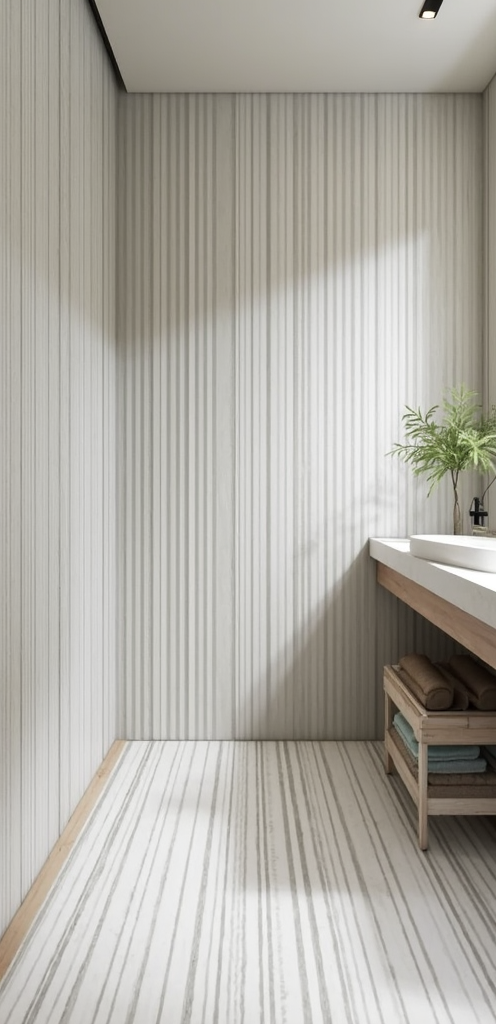
Vertical stripes can add striking visual interest to your bathroom, transforming plain walls or floors into a bold statement. By using tiles with vertical stripes, you create an illusion of height, making the space feel larger than it really is.
Choose colors that complement your existing decor. For example, soft tones can evoke calmness, while bolder hues create energy.
When installing, consider varying the width of the stripes for added depth. You can mix straight lines with narrower accents to keep it dynamic.
Keep grout lines in mind; aligned stripes can improve the effect and create a cohesive look. Remember, proper installation is key, so use a level to guarantee your stripes are perfectly straight.
Minimalist Designs
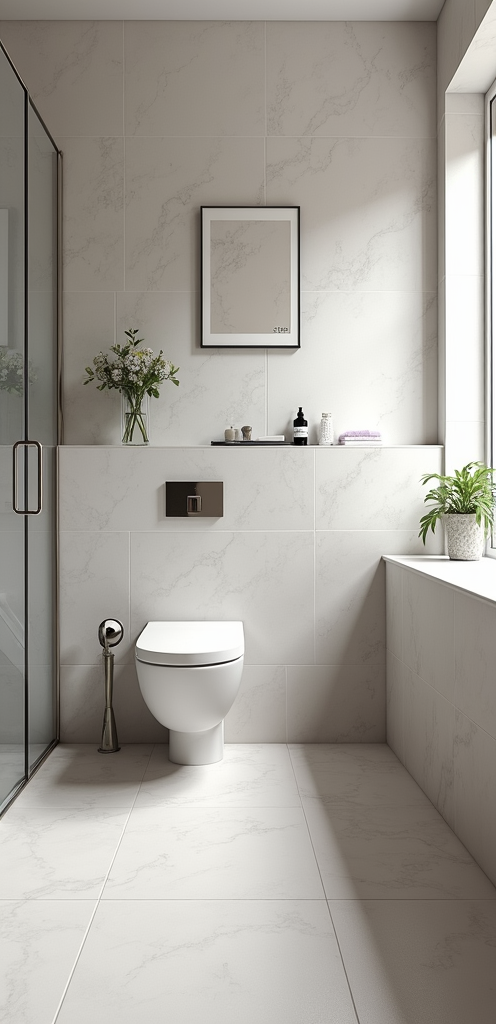
When you adopt minimalist designs in your bathroom, you’re opting for simplicity that speaks volumes. This approach emphasizes clean lines, neutral colors, and uncluttered spaces.
Start by choosing a solid, light-colored tile. Options like white, beige, or soft gray work well to create an airy feel. Geometric patterns in understated tones can add interest without overwhelming the eye.
In addition to tile, limit your fixtures and accessories. A single statement piece, such as a sleek sink or a modern faucet, can improve the minimalist vibe.
Make sure to select storage solutions that hide clutter, like built-in shelves or cabinetry. By focusing on these elements, you’ll achieve a revitalizing and organized bathroom that feels spacious and serene.
Optical Illusions
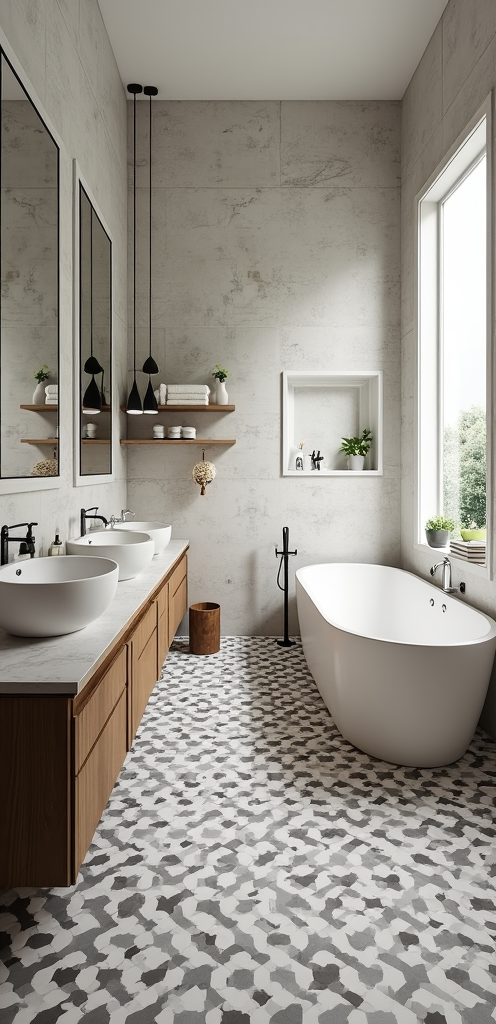
There’s something enchanting about using optical illusions in bathroom floor tiles. They can create depth or make a small space feel larger.
For instance, consider herringbone patterns or chevrons. These designs draw the eye and add visual interest. You might choose tiles with contrasting colors to improve this effect.
Square tiles arranged diagonally can also trick the eye, making the area appear more spacious. If you’re adventurous, go for 3D designs that create shadows or shapes.
Just remember to balance your choice with the rest of your bathroom decor. A busy floor can overwhelm, so pair bold patterns with neutral walls.
Ultimately, using optical illusions in your tiles can transform how you perceive and experience your bathroom.
Textured Tiles
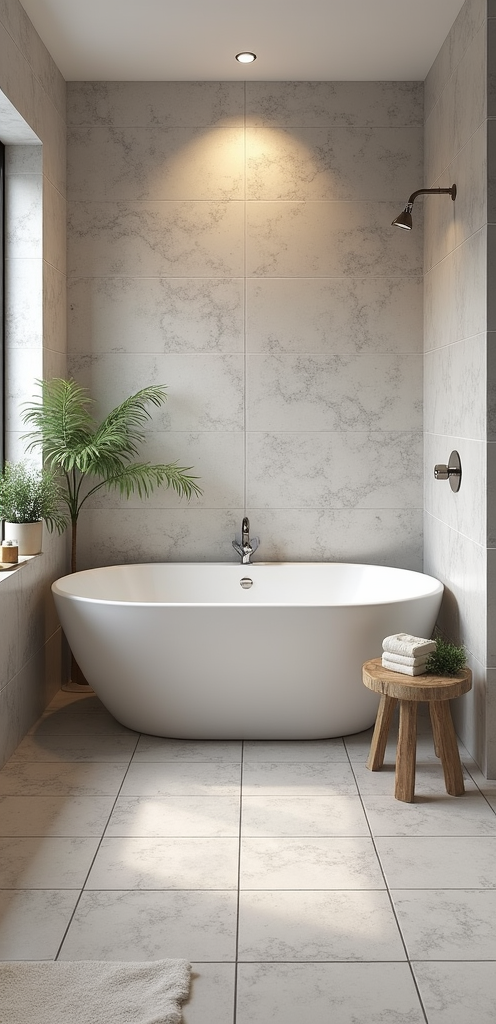
Textured tiles often add a dynamic element to bathroom floors, enhancing both aesthetics and safety. They come in various styles, like matte, gloss, or natural stone finishes, giving you options that can match your theme.
Textured surfaces provide better traction, reducing the risk of slips, especially when the floor is wet.
When choosing textured tiles, consider the size and layout of your space. Larger tiles can make a small room feel more expansive, while smaller tiles can create a cozy, inviting atmosphere.
Pay attention to the grout lines, as they can also influence the overall look. Additionally, make certain that the texture isn’t overly pronounced; it should be functional yet comfortable underfoot.
This balance will help create a stylish and safe environment.
Multi-Functional Accessories
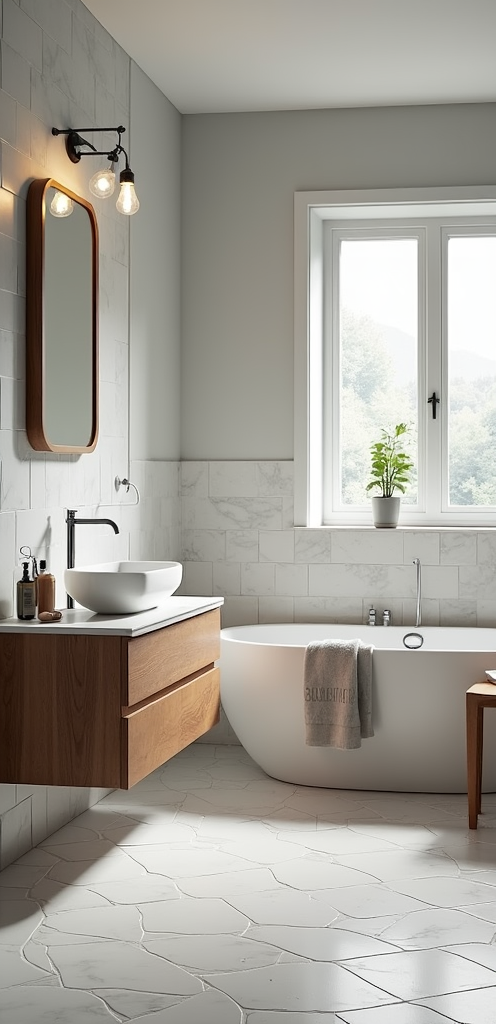
Incorporating multi-functional accessories can transform your bathroom into a more practical and organized space. Consider a combination of shelves and towel racks. These let you keep your towels handy while providing a space to store toiletries.
Next, look for mirrors that double as storage. They can hold small items, helping reduce clutter.
A over-the-toilet storage unit is another smart choice. It uses vertical space effectively without taking up floor area.
Also, try baskets and bins to organize items like cleaning supplies and extra toilet paper.
Finally, choose a stool that can serve as seating and storage. By thinking creatively about how you use accessories, you’ll make the most of your small bathroom while keeping it stylish and functional.

